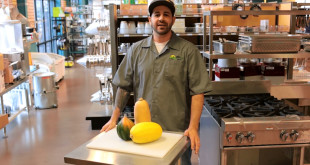Do you know the difference between a Chef Knife, Santoku Knife, Paring Knife, and Slicing Knife? We found out that a lot of you are confused on what knife you should be using when making certain cuts, which is exactly why we had Chris make another video for you! Chris not only walks through what each knife is used for, but also shows you helpful cutting tips for tomatoes, onions, oranges, and meats.
Special thanks to Bar Lilly at the Broker Inn.
List of Products Used in Video
- White Cutting Board
- Wood Butcher’s Block
- Victorinox Stamped 8 inch Chef Knife
- Mercer Genesis 7 inch Santoku Knife
- Victorinox 4 inch Paring Knife
- Mercer Millenia 11 inch Slicing Knife
- Mercer Blade Guards
Video Transcription
Chris: Hello. Welcome. I’m Chris Tavano and this is another episode of Tundra Restaurant Supply Do-It-Yourself Knife Know-How. Today we’re in the kitchen of Bar Lilly at the Broker Inn in Boulder.
So today we’re going to talk about knife essentials in the kitchen. We’ve got a wide range of your honing rod, your slicing knife, a serrated bread knife, a santoku, or a chef’s knife, we’ve got both, as well as a paring knife. We’re going to start off with a chef knife and a santoku knife and talk about the differences within them.
We’re using some quality cutting surfaces, an NSF certified plastic polyurethane cutting board or a nice wood butcher’s block that is oiled and cured for food safety. Briefly I want to talk about the anatomy of a knife that every blade and every knife has is the tip, the blade itself, as well as the cutting edge which goes into the heel which goes to the bolster, easier to see on here, which goes into the tang, and the tang is something that goes throughout the handle. The difference with the tang between the forged and stamped models, the best way to think about that is a stamped model is much like a license plate manufacturer whereas the forged is much like a blacksmith.
This is probably the most versatile knife in any kitchen could be used for many purposes especially if you are short on any other kind of knife. Right here we are using a Victorinox stamped eight inch chef’s knife. The best one I like to think of is holding it in the middle of these two fingers. If you like to play drums it’s much like holding a drumstick, and you’re going to put that right where the bolster meets the handle, and you’re going to just lightly wrap your index finger around that, and then from there you can get any kind of chopping motion or slicing motion appropriate to whatever food you’ll be working with.
The first versatile piece of fruit or vegetable in the kitchen for a chef’s knife would be the tomato. I’ll show you two ways on how to slice and dice this. Be sure to keep your blade as sharp as possible. We’ve demonstrated that in a different video, Sharpening vs. Honing. Big thing here is you do not want to go straight down on the tomato. It’s got a very sensitive skin so you’re going to want to be pushing forward as you go down. What you do from here is take all those slices that you just had, stack them up nice and high, and from here we’re going to get the nice little dice. Then rotate it 90 degrees. Then you’ve got it going the other way. Be careful you don’t stack too high and it slips out of the bottom, and then you’re going to get a little imperfect dice.
So some recipes call for tomatoes being seedless so I’ll show you how to do that now using a cored tomato that I’ve already prepped. Start cutting it into quarters, and then from there we take out the seeds much like you will a pepper. I’ll show you that in a minute, and just set those flesh pieces right off to the side. So now that you’ve got all your flesh pieces just want to slice these into little julienne strips, and then from there you just take all your julienne strips and then go the opposite direction. Try and get a nice quarter inch dice.
Next, we’ve got the santoku knife, the Mercer Genesis high carbon German steel blade is what we have. It is also very comparable to a chef’s knife, very versatile and used for many applications. This particular santoku has a granton edge often called a fluted edge or a hollow edge, but the technical term is granton, and basically this creates air pockets between the blade and the food so that way it’s easier to come off the blade after you’ve made a cut. Here is just one of two cutting techniques on an onion that we typically like to use. Save this piece for your scraps, your stockpots and whatnot. Peel the first layer of skin back on the onion. Keep the root intact because that’s going to come in very handy for a various reasons. We’re going to do a dice here, and probably make about a quarter inch slice all the way through different layers of the onion applying a little bit of pressure on the top to keep it in place and don’t go all the way through like I had just done. Come back the other way with the tip of your Santoku, and we’re going to make little slices all the way about three quarters of the way through down to the root so that way theoretically it would all stay intact, and then from here you can make nice slicing motions on the onion and you’ve got your great quarter inch dice.
So next we’ve got the paring knife. Here I’ve got a four inch Victorinox paring knife. Paring knives are great for when your chef’s knife or santoku knife doesn’t quite get the job done as far as accuracy, precision or detail or creating that nice fine cut that you need. So right now we’re going to use that Victorinox paring knife on an orange and show you how to segment citrus. So I like to hold it like the drumstick again in your fulcrum right at the bolster, and then use the tip of your index finger near the tip of the blade so that way you get that nice precision accuracy. And you can use that to core certain stuff. I’ll show you here as we segment, but we’re going to segment this orange. We’re going to slice off the tops and bottoms, and then from here I’m just going to do a nice rounding pattern to get this pith out of here. So here you save the scraps great for incense, great for candles, soaps, etc., etc. Now, here you can see the orange. You can see the individual segments themselves so you’re going to take your paring knife and just go on the inside of one of those pith areas and create a little V and you’re going to cut out that segment, and on to the next one.
All right, next we’ve got a slicing knife. Here we’re using the Mercer Millenia series. It’s an eleven inch granton edge slicing knife. So here we’re going to slice this beautiful, rested and seasoned pork chop that came off the grill. Here instead of going down and making your slices, we want to cut on the bias so you’re going to rotate your blade down and just cut off that first nice little edge, and then from there about a quarter inch back every single time putting firm pressure on the back of the chop so that way it doesn’t slide away from you, and try and get full slices of the blade forward and then back. Forward through the meat, and as you come back you should be in contact with the board cutting the chop all the way down through the bottom, forward and back. So other applications for the slicing knife specifically is that way you’re not sawing through your meat. Again, slicer knives are mostly for proteins. Any kind of chef knife, paring knife, or boning knife, filet knife, you’re not going to get that nice smooth cut from front to back on your protein. Again, you want to stay away from any kind of sawing motions when using a knife, and having a nice long slicing blade is going to allow you to do that in a large piece of protein.
There are other variations of a slicing knife as well. There’s what is called the serrated edge. A lot of times you see this slicing knife for bread something that is a little bit more hard or crusty on the outer surface so that way you can actually get through it.
One other point to mention though is always be sure to properly take care of your knives when washing and storing them. Be sure that you’re always hand washing your knives. Never put them in a dishwasher because the temperatures are way too high especially for the handles, and if you have a wood handle it’s just going to destroy it. We’ve got these nice little blade guards from Mercer, and they’re great for protecting your knives’ honed and sharpened new blade steel.
And that sums up another episode of Knife Know-How from the kitchen of Bar Lilly at the Broker Inn in Boulder, Colorado. I’m Chris Tavano from Tundra Restaurant Supply and to better mise en place!
Before taking action from the content or resources published here, we request that you visit and review our terms of use.
 Corner Booth Blog | TundraFMP Restaurant Supply, News & Equipment Blog
Corner Booth Blog | TundraFMP Restaurant Supply, News & Equipment Blog



